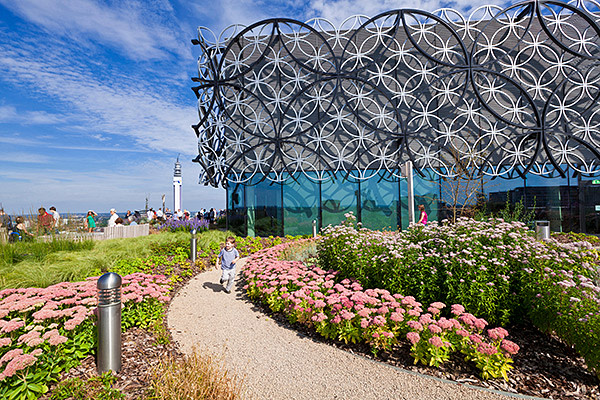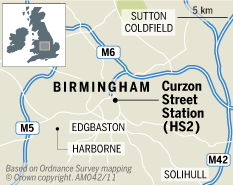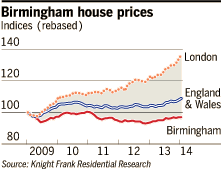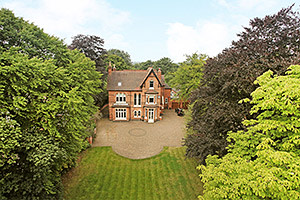Could the HS2 rail link revive Birmingham’s property market?

Simply sign up to the Life & Arts myFT Digest -- delivered directly to your inbox.
Birmingham’s housing market recovery may be lagging behind many other parts of the country but the city’s estate agents are pinning their hopes for a renaissance on one specific infrastructure improvement – the HS2 rail project.
The project is still in its early stages and is vulnerable to a change in political sentiment. However, should it go ahead, from 2026, Birmingham would be the first stop – and for some years, the only stop – on northbound HS2 services from London, and the current 85-minute train journey would be slashed to 50 minutes.
The £50bn line could eventually run to Manchester, Sheffield and Leeds, too, but many claim Birmingham is already the biggest winner, 12 years before the first train is due to arrive. The rail service operator, HS2 Ltd, is holding seminars in the city this spring asking residential and commercial builders how the project can “raise awareness and understanding of the development opportunities and maximise local benefits”.
Some estate agents believe that the two-and-a-half hour car journey from central Birmingham to central London deters people from living in the West Midlands city, while the prospect of a mere 50 minutes on a train may reverse that trend.
“HS2 is already having a positive effect. The Hive development [of low-cost flats] is located very close to the anticipated terminal and has been the best-selling new-build scheme in the city over the last two years,” says Mark Evans of Knight Frank.

His hope is that HS2 would revive Birmingham and especially its city centre as a place to live. At present only 2,500 people out of the total 1.1m population live within the centre and while average property prices across Birmingham have risen 3 per cent over the past year, slightly below the UK average, they remain 9 per cent down on 2007 levels.
For Birmingham, Britain’s second city with the largest population and GDP outside London, things looked very different seven years ago, before the downturn in the UK housing market. Then the city’s inner core was filled with flamboyant schemes, such as The Mailbox, a revamped old postal centre, and The Cube, an aluminium-clad 25-storey block, where asking prices were more than £500 per sq ft. The penthouse in a 24-storey tower was on sale for £1.65m and there were plans for a 50-storey project, which aimed to do the same for Birmingham that the Sears Tower did for Chicago.

Today the city centre market looks more modest. Property consultant Jones Lang LaSalle says most new-build schemes in Birmingham are priced at £220 to £250 per sq ft with a few in prime sites at £300. There is only a small pipeline of new schemes. “There were far too many apartments of all shapes and sizes built in the city centre and the market was completely flooded. These have now dropped significantly in price,” says Sue Bennett of Hadleigh estate agency.
Now high-end buyers look not to the centre but instead at two affluent suburbs with good schools – Edgbaston and Harborne – plus easily accessible areas outside the city.
Edgbaston has 20,000 residents living in a range of Georgian, Victorian and interwar family houses. The area was spared the substantial industrial and commercial developments seen in much of the rest of Birmingham thanks to a ban on the construction of factories and warehouses in the 19th century. As a result, the area is leafy, quiet and regarded as one of the prime city addresses, yet less than two miles southwest of the centre. There are a number of houses in Edgbaston with substantial grounds, such as Aldorham, an eight-bedroom Victorian house set 200ft back from the road with 1.2 acres of grounds. The property is on sale through Fine & Country for £2.75m. Close by is a Georgian house with seven bedrooms, priced at £2.3m with Bowkett Briggs.

Harborne, a suburb just east of Edgbaston, consists mostly of 1930s houses with large gardens. Among the larger homes is an eight-bedroom house with 5,100 sq ft of living space, extensive parking and garaging, priced at £2.5m through Ribchester.
Purchasers in these locations include those working at the city’s four universities, returning expats and long-term visitors from overseas posted to major employers in the city such as Jaguar Land Rover and Cadbury Trebor Bassett.
Buyers looking further afield might wish to consider Solihull, nine miles from the centre and a 15-minute drive to Birmingham airport, or Sutton Coldfield, a town described as “Birmingham’s answer to Ascot” by James Way of Knight Frank because of its glut of high-end gated houses.
“The market hasn’t been strong for £1m-plus homes in the past year with very few active buyers but towards the end of last year we started to see signs of improvement,” says Way.
Local agents say some buyers considering Sutton Coldfield are being deterred by a proposal in the latest draft of the Birmingham Development Plan, which is the blueprint for building 80,000 new homes for an additional 150,000 city residents by 2031. The draft calls for up to 6,000 properties to be built on greenbelt land in the Sutton Coldfield area.
Local Conservative MP Andrew Mitchell claims the Sutton proposal is unnecessary as there is existing planning consent for 17,000 new homes within Birmingham, plus more than 11,000 empty existing homes. He says: “Everyone can accept that we need to build more but brownfield sites and existing permissions already granted should bear the brunt.”
Birmingham city council recognises it needs to do more to find sites for new homes and its current level of 1,300 new homes a year is well behind its own targets of 2,500 by 2016 and more than 3,000 annually from 2021.
With buyer numbers on the rise it may turn out that it is this longstanding shortage of homes, rather than a new train line to London, that lies behind a renaissance in Birmingham’s property prices in the near future.
——————————————-
Buying guide
● There were 622 crimes reported in central Birmingham in October 2013, an annual rise of 10 per cent
● 80,000 new homes are expected to be built across the city over the next 17 years
● Improving the city’s cultural offering is a key council objective
What you can buy for . . .
£500,000 A three- or four-bedroom semi-detached house
£1m A family house with a large garden in a popular suburb
£2.5m A Victorian mansion, plus an acre of grounds in Edgbaston
Comments